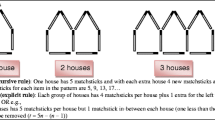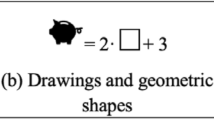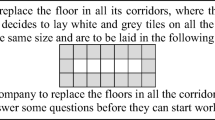Abstract
We conducted a descriptive exploratory study in which we analyzed 313 sixth to eighth grade students’ answers to a word problem, accompanied by diagrams, involving generalization in an algebraic functional context. In this research, we jointly addressed two objectives: (a) to determine the strategies deployed by students to generalize and (b) to identify the types of representation used to express their generalizations. We integrated how regularities are produced, evidenced in structures and represented by students. One of the most prominent findings was that functional strategy was used by almost all the students who generalized. They expressed the generalization using verbal, symbolical, or multiple representations. Ways of expressing regularities that are not restricted to algebraic symbolism are also shown. Although the potential to identify functional relationships was observed in sixth graders, seventh and eighth school students were able to represent more varied and structurally complex relationships. However, no relevant differences in generalization strategies were found between students of different ages with and without previous algebraic training.










Similar content being viewed by others
References
Akkan, Y. (2013). Comparison of 6th-8th graders’s efficiencies, strategies and representations regarding generalization patterns. Bolema, 27(47), 703–732. https://doi.org/10.1590/S0103-636X2013000400002
Amit, M., & Neria, D. (2008). “Rising to the challenge”: Using generalization in pattern problems to unearth the algebraic skills of talented pre-algebra students. ZDM, 40(1), 111–129. https://doi.org/10.1007/s11858-007-0069-5
Barbosa, A., Vale, I., & Palhares, P. (2012). Pattern tasks: Thinking processes used by 6th grade students. Revista Latinoamericana De Investigación En Matemática Educativa, 15(3), 273–293.
Becker, J. R., & Rivera, F. (2005). Generalization strategies of beginning high school algebra students. In H. L. Chick & J. L. Vincent (Eds.), Proceedings of the 29th Conference of the International Group for the Psychology of Mathematics Education. 4, 121–128. PME.
Blanton, M. L., Brizuela, B. M., Gardiner, A., Sawrey, K., & Newman-Owens, A. (2015). A learning trajectory in 6-year-olds’ thinking about generalizing functional relationships. Journal for Research in Mathematics Education, 46(5), 511–558. https://doi.org/10.5951/jresematheduc.46.5.0511
Blanton, M. L., Isler-Baykal, I., Stroud, R., Stephens, A., Knuth, E., & Gardiner, A. (2019). Growth in children’s understanding of generalizing and representing mathematical structure and relationships. Educational Studies in Mathematics, 102, 193–219. https://doi.org/10.1007/s10649-019-09894-7
Blanton, M. L., & Kaput, J. J. (2004). Elementary grades students’ capacity for functional thinking. In M. J. Hoines, & A. B. Fugslestad (Eds.), Proceedings of the 28th International Group for the Psychology of Mathematics Education. 2, 135–142. PME.
Blanton, M. L., Levi, L., Crites, T., & Dougherty, B. J. (Eds.) (2011). Developing essential understanding of algebraic thinking for teaching mathematics in grades 3–5. NCTM.
Cañadas, M. C., & Molina, M. (2016). Una aproximación al marco conceptual y principales antecedentes del pensamiento funcional en las primeras edades [An approach to the conceptual framework and background of functional thinking in early years]. In E. Castro, E. Castro, J. L. Lupiáñez, J. F. Ruíz, & M. Torralbo (Eds.), Investigación en Educación Matemática. Homenaje a Luis Rico (pp. 209-218). Comares.
Carraher, D. W., Martinez, M. V., & Schliemann, A. D. (2008). Early Algebra and Mathematical Generalization. ZDM, 40(1), 3–22. https://doi.org/10.1007/s11858-007-0067-7
El Mouhayar, R., & Jurdak, M. (2015). Variation in strategy use across grade level by pattern generalization types. International Journal of Mathematical Education in Science and Technology, 46(4), 553–569. https://doi.org/10.1080/0020739X.2014.985272
El Mouhayar, R., & Jurdak, M. (2016). Variation of student numerical and figural reasoning approaches by pattern generalization type, strategy use and grade level. International Journal of Mathematical Education in Science and Technology, 47(2), 197–215. https://doi.org/10.1080/0020739X.2015.1068391
Güner, P., Ersoy, E., & Temiz, U. (2013). 7th and 8th grade students’ generalization strategies of patterns. International Journal of Global Education, 2(4), 38–54.
Hunter, J., & Miller, J. (2022). The use of cultural contexts for patterning tasks: Supporting young diverse students to identify structures and generalise. ZDM, 54, 1349–1362.
Kaput, J. J. (1999). Teaching and learning a new algebra. In E. Fennema & T. A. Romberg (Eds.), Mathematics classrooms that promote understanding (pp. 133–155). Lawrence Erlbaum Associates.
Kaput, J. J. (2008). What is algebra? What is algebraic reasoning? In J. J. Kaput, D. W. Carraher, & M. L. Blanton (Eds.), Algebra in the early grades (pp. 5–17). Lawrence Erlbaum Associates.
Küchemann, D. (2010). Using patterns generically to see structure. Pedagogies, 5(3), 233–250. https://doi.org/10.1080/1554480X.2010.486147
Lannin, J., Barker, D., & Townsend, B. (2006). Algebraic generalization strategies: Factors influencing student strategy selection. Mathematics Education Research Journal, 18(3), 3–28. https://doi.org/10.1007/BF03217440
Lepak, J. R., Wernet, J. L., & Ayieko, R. A. (2018). Capturing and characterizing students’ strategic algebraic reasoning through cognitively demanding tasks with focus on representations. The Journal of Mathematical Behavior, 50, 57–73. https://doi.org/10.1016/j.jmathb.2018.01.003
Mason, J., Graham, A., & Johnston-Wilder, S. (2005). Developing thinking in algebra. The Open University and Paul Chapman Publishing.
Merino, E., Cañadas, M. C., & Molina, M. (2013). Uso de representaciones y patrones por alumnos de quinto de educación primaria en una tarea de generalización [Representations and patterns used by fifth grade students in a generalization task]. Edma 0-6, 2(1), 24–40.
Molina, M. (2014). Traducción del simbolismo algebraico al lenguaje verbal: Indagando en la comprensión de estudiantes de diferentes niveles educativos [Translation of algebraic symbolism to verbal language: Inquiring the understanding of students of different educational levels]. La Gaceta de la RSME, 17(3), 559–579.
Morales, R., Cañadas, M. C., Brizuela, B. M., & Gómez, P. (2018). Relaciones funcionales y estrategias de alumnos de primero de educación primaria en un contexto funcional [Functional relationships and strategies of first graders in a functional context]. Enseñanza de las Ciencias, 36(3), 59–78. https://doi.org/10.5565/rev/ensciencias.2472
Moss, J., & Beatty, R. (2006). Knowledge building in mathematics: Supporting collaborative learning in pattern problems. International Journal of Computer-Supported Collaborative Learning, 1(4), 441–465. https://doi.org/10.1007/s11412-006-9003-z
Pinto, E., & Cañadas, M. C. (2017). Estructuras y generalización de estudiantes de tercero y quinto de primaria: un estudio comparativo [Structures and generalisation in third and fifth year of primary school: A comparative study]. In J. M. Muñoz-Escolamo, A. Arnal-Bailera, P. Beltrán-Pellicer, M. L. Callejo, & J. Carrillo (Eds.), Investigación en Educación Matemática XXI (pp.407-416). SEIEM.
Pinto & Cañadas (2021)Pinto, E., & Cañadas, M. C. (2021). Generalizations of third and fifth graders within a functional approach to early algebra. Mathematics Education Research Journal, 33, 113–134. https://doi.org/10.1007/s13394-019-00300-2
Pinto, E., Cañadas, M. C., & Moreno, A. (2021). Functional relationships evidenced and representations used by third graders within a functional approach to early algebra. International Journal of Science and Mathematics Education. https://doi.org/10.1007/s10763-021-10183-0
Pólya, G. (1989). ¿Cómo plantear y resolver problemas? [How to solve it?] Trillas.
Radford, L. (2010). Layers of generality and types of generalization in pattern activities. PNA, 4(2), 37–62. https://doi.org/10.30827/pna.v4i2.6169
Radford, L. (2018). The emergence of symbolic algebraic thinking in primary school. In C. Kieran (Ed.), Teaching and learning algebraic thinking with 5- to 12-year-olds (pp. 3–25). Springer.
Ramírez, R., & Cañadas, M. C. (2018). Nominación y atención del talento matemático por parte del docente [Nomination and attention to mathematical talent by the teacher]. UNO. Revista de Didáctica de las Matemáticas, 79, 23–30.
Ramírez, R., Cañadas, M. C., & Damián, A. (2022). Structures and representations used by 6th graders when working with quadratic functions. ZDM, 54, 1393–1406.
Rico, L. (1997). Consideraciones sobre el currículo de matemáticas para educación secundaria [Considerations about secondary education mathematics curriculum]. In L. Rico (Coord.), La Educación Matemática en la enseñanza secundaria (15–38). Horsori.
Rivera, F., & Becker, J. R. (2005). Teacher to teacher: Figural and numerical modes of generalizing in algebra. Mathematics Teaching in the Middle School, 11(4), 198–203. https://doi.org/10.5951/MTMS.11.4.0198
Smith, E. (2008). Representational thinking as a framework for introducing functions in the elementary curriculum. In J. J. Kaput, D. W. Carraher, & M. L. Blanton (Eds.), Algebra in the early grades (pp. 133–160). Lawrence Erlbaum Associates.
Stacey, K. (1989). Finding and using patterns in linear generalizing problems. Educational Studies in Mathematics, 20(2), 147–164. https://doi.org/10.1007/BF00579460
Stephens, A., Ellis, A., Blanton, M. L., & Brizuela, B. M. (2017). Algebraic thinking in the elementary and middle grades. In J. Cai (Ed.), Compendium for research in mathematics education (pp. 386–420). NCTM.
Torres, M. D., Brizuela, B. M., Moreno, A., & Cañadas, M. C. (2022). Introducing tables to second-grade elementary students in an algebraic thinking context. Mathematics, 10, 56.https://doi.org/10.3390/math10010056
Torres, M. D., Cañadas, M. C., & Moreno, A. (2019). Estructuras y representaciones de alumnos de 2º de primaria en una aproximación funcional del pensamiento algebraico [Second graders’ structures and representations used in a functional approach of algebraic thinking]. In J. M. Marbán, M. Arce, A. Maroto, J. M. Muñoz-Escolano, & Á. Alsina (Eds.), Investigación en Educación Matemática XXIII (pp. 573-582). SEIEM.
Ureña, J., Ramírez, R., Cañadas, M. C., & Molina, M. (2022). Generalization strategies and representations used by final-year elementary school students. International Journal of Mathematical Education in Science and Technology. https://doi.org/10.1080/0020739X.2022.2058429
Ureña, J., Ramírez, R., & Molina, M. (2019). Representations of the generalization of a functional relationship and the relation with the interviewer’s mediation. Infancia y Aprendizaje, 42(3), 570–614. https://doi.org/10.1080/02103702.2019.1604020
Warren, E., Trigueros, M., & Ursini, S. (2016). Research on the learning and teaching of algebra. In A. Gutierrez, G. C. Leder, & P. Boero (Eds.), The second handbook of research on the psychology of mathematics education (pp. 73–108). Sense Publishers.
Wilkie, K. J. (2016). Students’ use of variables and multiple representations in generalizing functional relationships prior to secondary school. Educational Studies in Mathematics, 93, 333–361. https://doi.org/10.1007/s10649-016-9703-x
Wilkie, K. J., & Clarke, D. M. (2016). Developing students’ functional thinking in algebra through different visualisations of a growing pattern’s structure. Mathematics Education Research Journal, 28, 223–243. https://doi.org/10.1007/s13394-015-0146-y
Zapatera Llinares, A. (2018). Cómo alumnos de educación primaria resuelven problemas de generalización de patrones. Una trayectoria de aprendizaje [How primary education students solve problems of generalization of patterns. A learning trajectory]. Revista Latinoamericana de Investigación en Matemática Educativa, 21(1), 87–114. https://doi.org/10.12802/relime.18.2114
Funding
It was funded by Spain’s National Research Agency (Spanish initials, AEI) and the European Regional Development Fund (ERDF) under projects EDU2016-75771-P, EDU2017-84377-R (AEI/ERDF, EU), and PID2020-113601 GB-I00.
Author information
Authors and Affiliations
Contributions
Jason Ureña: conceptualization, data analysis, original draft preparation, and writing—review and editing. Rafael Ramírez: conceptualization, methodology, task design, data collection, supported and validated the analysis, and writing—review and editing. Marta Molina: methodology, supported and validated the analysis, and writing—review and editing. María C. Cañadas: methodology, task design, data collection, supported and validated the analysis, and writing—review and editing.
Corresponding author
Ethics declarations
Ethics approval
All the information published complies with the requirements of confidentiality, anonymity, and the necessary guarantees and permissions for its disclosure.
Competing interests
The authors declare no competing interests.
Disclosure
This study was conducted in the context of the first author’s pursuit of a PhD, from the University of Costa Rica.
Additional information
Publisher's Note
Springer Nature remains neutral with regard to jurisdictional claims in published maps and institutional affiliations.
Rights and permissions
Springer Nature or its licensor (e.g. a society or other partner) holds exclusive rights to this article under a publishing agreement with the author(s) or other rightsholder(s); author self-archiving of the accepted manuscript version of this article is solely governed by the terms of such publishing agreement and applicable law.
About this article
Cite this article
Ureña, J., Ramírez, R., Molina, M. et al. Generalization: strategies and representations used by sixth to eighth graders in a functional context. Math Ed Res J (2023). https://doi.org/10.1007/s13394-023-00458-w
Received:
Revised:
Accepted:
Published:
DOI: https://doi.org/10.1007/s13394-023-00458-w




